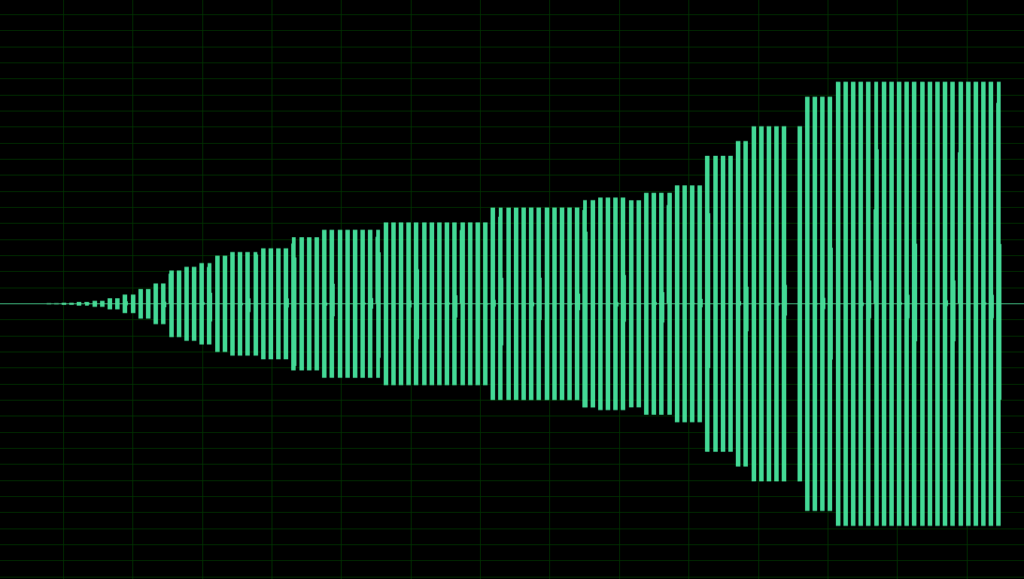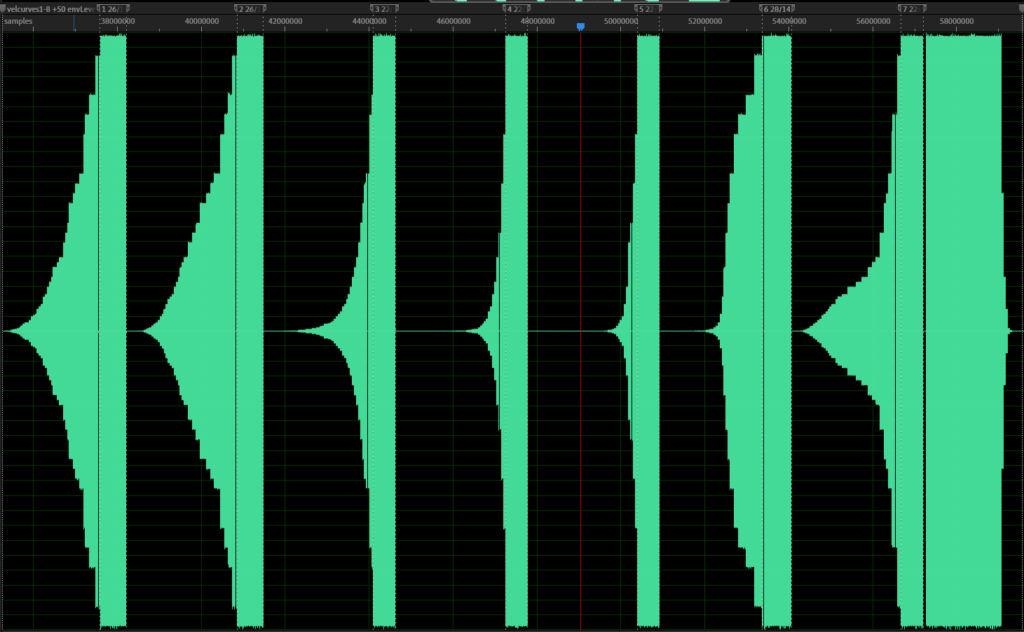Some users reported that the velocity response of my K1v plugin is quite different compared to the K1 hardware. And yes, that is probably the area with the biggest difference between the K1v and the K1.
As I have pointed out in an earlier article, tracking down the velocity curves is very difficult, as there is no way to get the raw velocity data. What you will capture on the audio out is always the envelope volume – modulated by the velocity curve. Getting the raw velocity data is impossible.
A different approach – using the K1m Firmware ROM
While sitting here and thinking about how to solve the unsolvable problem, I had an idea. The K1 needs to have the curves stored somewhere. I used my PHm ROM that I have dumped earlier and loaded it as raw data into my wave editor.
It didn’t took very long until I found interesting data tables that looked similar to the velocity curve graphs in the manual. Actually, there a plenty of data tables in there. Not only velocity, I also found the key scaling curves and lots of other tables. I still need to figure out what they are for, but the result will be a much better precision in the K1 emulation.

The velocity curves have a length of 64 bytes each and have a range of 0 to 127, as you’d expect for velocity values. I extracted them from the ROM and used them in the K1v, but unfortunately they did not really match the K1 output.
Some things that I observed:
- Velocity Curve 1, that is supposed to be linear, is not linear. Velocity Curve 3 is linear although it should not.
- In my recordings, for most curves, velocity values above 100 do not make any difference anymore. But the curves have proper values, why aren’t they used?
Data Analysis
Lets first have a look at what the manual says VS what is in the data:


What can be seen immediately is that all curves in the ROM are less exponential than required.
Furthermore, not the whole velocity range is used, at least not when modulating envelope volume. Take a look at the picture below, this is a K1 recording of Velocity Curve 1 with all velocity values from 1 to 127.

As you can see, envelope volume is peaking way before velocity maximum. To be precise, the maximum envelope level is reached already at velocity 102. I made the gap in the recording on purpose by inserting a quarter after velocity 100 so I had to count less bars to find the values 😊.
The same applies to all other curves. Either the incoming velocity values are fed through some other table before the curve is applied, or afterwards. By testing different values and their result, I was able to verify that there must be another remapping before the velocity curves are applied.
Implementation details
It took me many hours, a lot of guessing, thinking & testing before I found the correct table in the firmware ROM. It turned out that it is a table with a length of 64, it looks like this:

This curve explains why very high velocity values do not make any difference anymore, they are cut off. Furthermore, the whole curve makes everything a little bit more exponential.
I was pleased with the result: I had steps in envelope volume values at the same velocity values than my K1m. The but came quickly as the values didn’t match the K1m.


To make the result more exponential, I had to search for a table with a specific size: The envelope level has a range of 0 to 100, so a table with 101 values had to be the correct one.
As I had worked on this topic for such a long time, my source code with all kinds of tables grew more and more 😁 And now definitely needs some cleanup.

Luckily, I found the correct table within one hour or so. It is a 16 bit table, it has a length of 101 as expected and makes the curves identical to the K1m.

Once more, Velocity Curve 7 as being output by the K1v, now 100% accurate:

You might see that there are very small differences due to rounding errors, but these shouldn’t really matter.
Two more pictures, a comparison of all velocity curves in all its glory 👍


Pending work
As I have confidence about what tables make up correct velocity curves, I need to implement proper modulation levels. So far, everything you see is at Vel => Env Mod +50, i.e. 100%. Special care needs to be taken when implementing the modulation strength as I currently have the impression that a value of +25 does not mean a modulation strength of 50%, there might be another remapping table being inserted to do this. Negative strengths are another topic that might be interesting.
Of course, once I’m done there will be another post to announce the release of the update.
Other useful data tables in the firmware ROM?
There are some other tables in the ROM, both 8 bit and 16 bit with data that looks interesting. If I can figure out what they are used for, I can improve the emulation a lot.


For the latter curve, it looks very similar to one of my own curves that I had figured out by analyzing wave data.
Conclusion
If I ever go to emulate another synthesizer, putting more effort into ROM analysis instead of recording hours of data is the better way to go 😊 Stay tuned & thanks for reading!
Fantastic. I salute you, Sir!
Thanks Nils!
Great article and very promising output.
Good to have insight into a scientist’s work!
This is really exciting and captivating, even though I barely understood most of the article. Thank you for putting out these wonderful blog posts and keep’em coming!
Lic. Ezequiel Morfi | TITANIO
Buenos Aires, Argentina.-
Hi NilsS,
I mentioned in a previous reply on the gearslutz forum that it would be great to apply your Kawai K1v method, to other synths of that era like the Yamaha TG series maybe the TG55 for example, which would be the easiest to make a VSTi of. I have since realised that there is a download of the sample data from these synths and more, e.g. the actual Yamaha data from the chip. This can be downloaded from here https://app.box.com/s/is32xq2gyssjs8w0wznmdo7xr17tyvh9 . This link is from the long running hardware developer Sector101 https://www.sector101.co.uk/waveblade.html
PDF service manuals and MIDI data booklet exist if that helps, along with SY Programming PDFs that show mathmatical equations, formulas and tables used to create the synthesis.
Tell me what you think as I and many others would love to see a VSTi for at least one of these SY / TG synths.
Ian 🙂
hey how do i put new banks on my k1m hardwear using the plug in?
Hi, it is not possible to send a full patch to a hardware device via plugin functionality. What you can do though is to export them as Sysex files and transfer them with a tool of your choice, or even with the DAW. Best, Nils